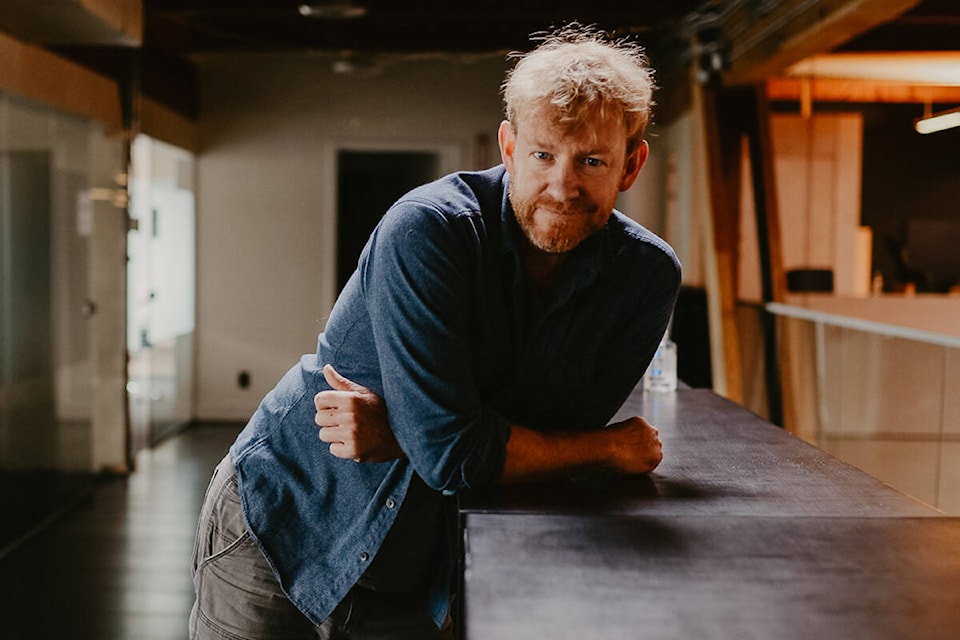- Words Lin Stranberg Photography by Julia Logliscia
Vancouver architect Michael Green is internationally known for his inventive, enviro-forward building style—especially when it comes to wooden buildings.
His accolades and awards are numerous, but he is not interested in lingering on past achievements. Instead, Michael appears to leap effortlessly from one passionate terrain to the next, as he amasses adventures and fulfills his creative drive through architecture and storytelling.
MGA, the Vancouver-based architectural practice Michael founded in 2012 and heads up with fellow principal Natalie Telewiak, is a hive of activity, pushing the limits of mass timber construction as the firm designs projects that range from private homes to large-scale master plans.
The busy Kitsilano studio has completed some of the most significant timber buildings in the world, including T3 in Minneapolis (Timber, Technology, Transit), which was the tallest wood structure in the US at the time of completion in 2016, and the Wood Innovation and Design Centre in Prince George, the tallest modern all-timber structure in the world when it was finished in 2014.
MGA has been recognized with more than 40 international awards for design excellence, including the Royal Architectural Institute of Canada Firm of the Year, Architizer’s Best in North America Firm Award, four Governor General’s Medals, two RAIC Innovation Awards, and the American Institute of Architects Innovation Award.
Most days, Michael drives over from his Kits Point home in his classic 1959 Range Rover Series II, now an electric vehicle. Converting older cars into electric vehicles is one of his latest passions, and he is enthusiastic about turning it into a new project called Adventure Green. It may have already happened. Details are blurred when he discusses the things that matter most to him: family, adventure, impact, meaning, responsibility, purpose.
“All these things to me are really beautiful,” he says. “And service—how we show up and what we do when we are there.”
Recognized as a global leader in wood construction and innovation, he serves as a government policy advisor on mass timber design, and speaks internationally on the subject of mass timber and new building technology. Alongside Jim Taggart (editor of Sustainable Architecture and Building Magazine), Michael co-authored the 2020 book Tall Wood Buildings: Design, Construction and Performance.
His 2013 TED talk, “Why We Should Build Wooden Skyscrapers,” has been viewed more than 1.4 million times. It’s absorbing and personal, especially when he describes why wood is the material he loves the most, and not simply for its ability to sequester carbon.
“Part of the reason I love it is that every time people go into my buildings that are wood, I notice they react completely differently. I’ve never seen anybody walk into one of my buildings and hug a steel or a concrete column, but I’ve actually seen that happen in a wood building,” he says.
“I’ve actually seen how people touch the wood, and I think there’s a reason for it. Just like snowflakes, no two pieces of wood can ever be the same anywhere on Earth. That’s a wonderful thing. I like to think that wood gives Mother Nature fingerprints in our buildings. It’s Mother Nature’s fingerprints that make our buildings connect us to nature in the built environment.”
Nature and adventure are pivotal to his being.
“Life is an adventure,” he says, speaking like someone who knows. His adventures are big—he’s an ice and mountain climber—and next fall he’s heading to a peak in Nepal.
“My adventures inform a lot of my choices,” he says. “By going into nature we find our centre—and that’s a big part of the art of life.”
He was born in the northerly hamlet of Qamani’tuaq in Nunavut (formerly Baker Lake in the Northwest Territories) and grew up in Vancouver, which he considers his hometown. His family history has led him to adventure, he says.
“The risk tolerance I’ve developed in climbing spills over into my life. It informs and inspires my architecture.”
What those risks look like, and what is inherent in them, can determine how his life unfolds. He is known for architecture, but it’s his range of interests that form who he is as an architect. He and his son have kayaked off several continents, including Antarctica, and he writes children’s books to “help nurture deeply creative children.”
He says he has written more than 14 children’s stories; the one he mentions frequently is Alpenglow, a story he wrote and illustrated about concentric rings of support planted for a windblown alpine flower. He wrote it in the context of designing a 72-family Ronald McDonald House in Vancouver, also modelled on a concentric support rings concept, designed specifically to foster strength of community.
Michael’s creative process combines worlds within worlds of the things he loves—architecture, art and the making of things—altering preconceptions and firing imaginations with his visionary analogies and shared stories.
“Storytelling remains one of the most important of the arts, and I tell my stories through buildings for community, family, climate, and to protect the world for our children and our children’s children.”
Story courtesy of Boulevard Magazine, a Black Press Media publication
Like Boulevard Magazine on Facebook and follow them on Instagram



